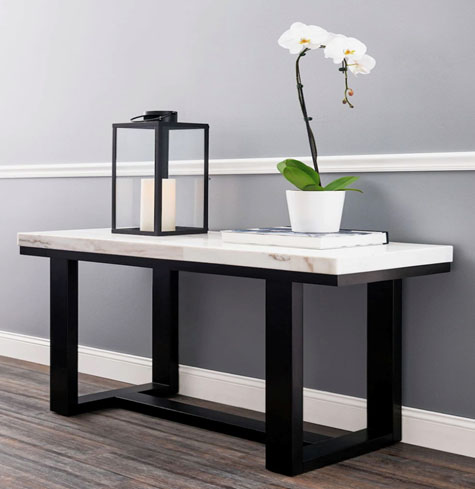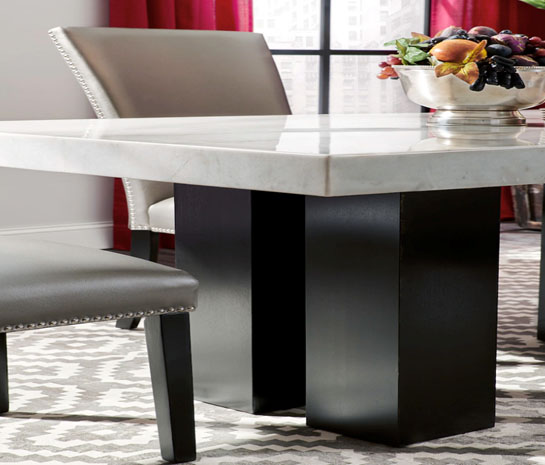Marble has been a common design element in kitchens practically forever, but now the luxe-looking material is having a serious moment in other spaces, too—like the dining and living room—in the form of freestanding furniture in particular.
“Marble can add such texture and character, and depending on [the style of the] material, can go very traditional or very modern,” says interior designer Georgia Tapert Howe. Even better: Marble feels equal parts modern and classic. Sold? Here’s everything you need to know about choosing and caring for marble furniture in your home.
WHAT DIFFERENT TYPES OF MARBLE ARE THERE?

Marble is essentially a crystallized form of stone—a metamorphic rock formed from other materials like limestone and dolomite. It hails from different quarries and regions all over the world, and the marble from each place has its own unique characteristics, from color to porosity.
You might’ve heard of (or seen) popular varieties like Carrara marble, which is quarried from Carrara, Italy and has fine veining. But there are actually hundreds of different types. For example: Yule marble from Colorado, Crema Marfil marble from Spain, Levadia Black marble from Greece, and many more. Because of different salts and minerals in each place, each variety has distinct patterns and colors, from vibrant greens and moody charcoals to metallic accents.
There are two different “patterns” to consider, too—there’s cross cut, which has a more open, flowered appearance, or vein cut, which is cut in a way that results in a more “striped” look.
Howe notes that statement-making, heavily veined marble is especially big right now. And warmer-hued varieties are also having a moment (for example, Calacatta Gold over Carrara, which can add a cozier element to a room).
You also have the option between polished or matte finishes—the latter tends to hide dull spots better, but there’s something about a glossy finish that feels particularly luxe.
HOW DO I CHOOSE THE RIGHT PIECE FOR ME?

Choosing the right marble piece (and deciding where to put it) comes down to personal preference. Bright white marbles make a classic, luxe statement in eating areas—as seen in the show-stopping Designer Looks Artemis Marble Dining Table (at Value City Furniture), for instance. Meanwhile, marbles that feature color can lend extra personality to your living room or bedside table.
The type of piece you’re looking for should also help determine what style of the stone you go with: “Personally, I think a coffee table or an accent table work well with a more heavily veined marble,” says Howe. “It’s not as big a commitment as a whole kitchen, so have a little fun.” That said, no matter which coloring or veining you go with, marble accents can bring an elegant balance of trendiness and timelessness to any space.
HOW DO I KEEP MARBLE FURNITURE IN TOP SHAPE?
As a strong material that can stand the test of time, real marble is a good choice if you’re looking for a long-term investment you’ll love for years to come. Like with many high-quality items, keeping your marble in tip-top shape requires some TLC.
Since marble stains and scratches more easily than other materials, make sure you wipe up spills ASAP. Acids are particularly abrasive and can leave dull spots on your marble, so avoid using acidic cleaners as well as cutting or serving acidic foods like lemons directly on pieces with marble tops.
Howe also recommends applying sealant, like MORE Anti-Etch, once a year. “Personally, the etching and staining [of marble] doesn’t bother me—I love when it looks like it’s been there for 100 years,” she says. “But if those things will drive you nuts, make sure you seal it.”
WHY GO WITH THE REAL THING OVER FAUX?
With real marble, no two slabs are exactly the same; faux marble is typically replicated for mass production. While the imitation kind can be easier to maintain and significantly less costly than the real deal—Howe notes real marble can run from about $13 to at least $160 per square foot, depending on the quality—real marble will often read more unique.
If you’re not sure where to start, opt for an accent piece, such as the Designer Looks Artemis Marble Console Table. You’ll be able to test the look in your own home before committing to larger—and pricier—pieces.



















Your Message